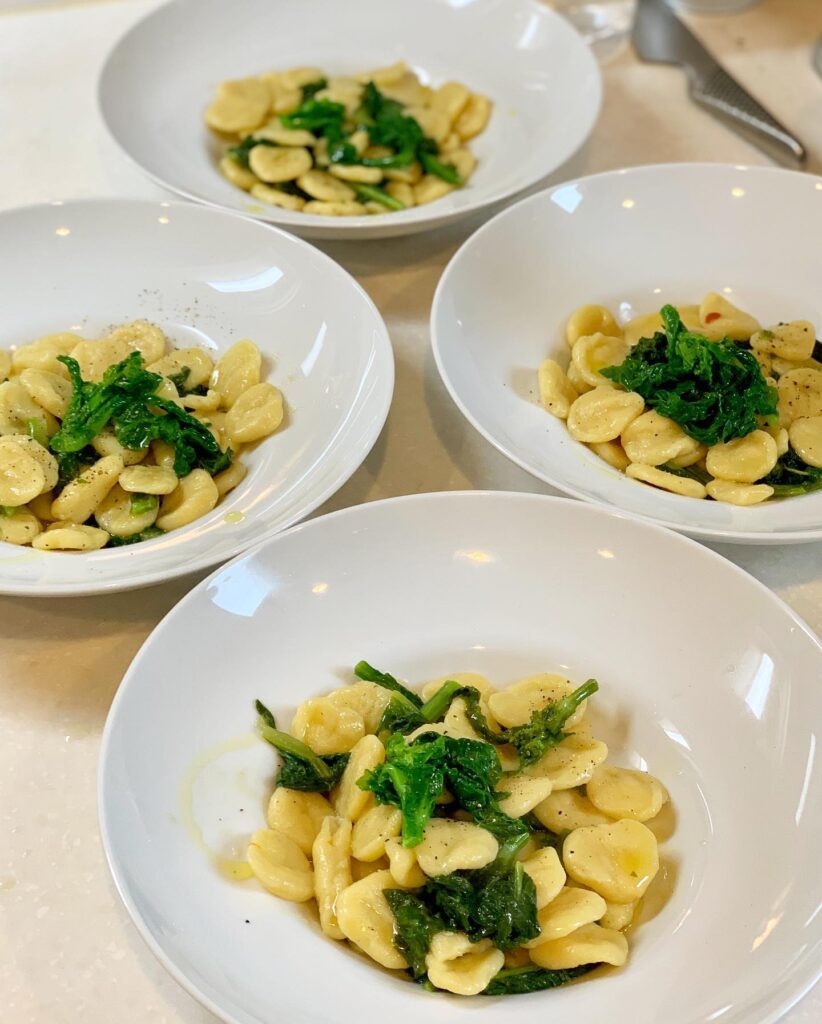Puglia, the sun-kissed region forming the heel of Italy’s boot, is not just a destination for stunning beaches and historic towns but a treasure trove of culinary traditions. At the heart of its gastronomic identity lies pasta, made with the simplest of ingredients yet celebrated worldwide for its texture, flavor, and adaptability. Unlike the richer egg-based pastas of northern Italy, Pugliese pasta embodies simplicity, crafted from durum wheat semolina and water.
 Pin
Pin Image source Instagram: @mattgraham_earthskills
Table of Contents
History of Pugliese Pasta
Puglia’s pasta tradition stems from its geography and historical frugality. The region is one of Italy’s largest producers of durum wheat, a crop that thrives in its dry, sunny climate. Historically, Puglia was a land of peasants where eggs were considered a luxury, reserved for special occasions. As a result, pasta made with just semolina and water became a staple, particularly in inland rural areas.
Over centuries, this practical innovation evolved into a culinary art form. Today, the pasta of Puglia is revered for its versatility and its ability to pair beautifully with both land-based and seafood ingredients, reflecting the dual agricultural and coastal nature of the region.
Unique Pasta Shapes of Puglia
Puglia’s pasta tradition stems from its geography and historical frugality. The region is one of Italy’s largest producers of durum wheat, a crop that thrives in its dry, sunny climate. Historically, Puglia was a land of peasants where eggs were considered a luxury, reserved for special occasions. As a result, pasta made with just semolina and water became a staple, particularly in inland rural areas.
Over centuries, this practical innovation evolved into a culinary art form. Today, the pasta of Puglia is revered for its versatility and its ability to pair beautifully with both land-based and seafood ingredients, reflecting the dual agricultural and coastal nature of the region.
1. Orecchiette: Puglia’s Signature Shape
 Pin
Pin Image source: Image by pixel1 from Pixabay
Let’s start with the undisputed queen of Pugliese pasta: orecchiette, translating to “little ears.” Their small, bowl-like form is deceptively simple yet brilliantly functional, capturing sauces like a tiny cradle of flavor.
Designed for Flavor
Orecchiette is the ultimate sauce carrier. Its concave shape and slightly rough texture make it perfect for gripping hearty combinations like cime di rapa (broccoli rabe with garlic and anchovies) or rich tomato-based ragùs. “Every bite is a perfect union of pasta and sauce,” says Claudia, a pasta artisan in Bari. “It’s like they’re made for each other!”
How It’s Made
Making orecchiette is a tactile, meditative process. Small pieces of dough are cut and pressed with a knife, then rolled and flipped with a thumb to form their signature curve. Traditionally, this is done by hand, with entire families gathering to create enough for festive meals.
Claudia adds with a laugh, “In Bari Vecchia, it’s practically a sport! You’ll see grandmothers shaping pasta faster than you can blink.” Walking through the narrow streets of Bari’s old town, it’s common to find women seated outside their homes, their hands moving rhythmically as they shape orecchiette with practiced precision.
Regional Highlight
Bari Vecchia, the historic heart of Bari, is the epicenter of orecchiette mastery. Every corner offers a glimpse into this living tradition, with locals proudly displaying trays of freshly made pasta outside their homes, drying in the warm Pugliese sun.
2. Cavatelli: The Versatile Scoop
 Pin
Pin Image source Instagram: @pastamalfi
If orecchiette is Puglia’s crown jewel, cavatelli is its workhorse. These small, shell-like pasta pieces are all about versatility, with their hollow centers ready to embrace chunky sauces, hearty soups, or creamy ricotta.
Designed for Hearty Pairings
Cavatelli shines when paired with thick textures. Imagine them bathed in a luscious tomato sauce, topped with chickpeas and greens, or swimming in a broth with seafood. Their modest design hides a world of culinary potential.
How It’s Made
Creating cavatelli is as simple as it is satisfying. The dough is rolled into long ropes, cut into small pieces, and pressed with the fingers to create a slight indentation. This hollow center is what makes cavatelli so effective at soaking up flavor.
“Making cavatelli is a family affair,” shares Lucia, a home cook from northern Puglia. “Even the kids join in, rolling and pressing the dough. It’s a way to pass on our traditions.”
Regional Highlight
In northern Puglia and the neighboring region of Molise, cavatelli is often paired with rustic ingredients like fava beans, garlic, and sautéed greens—a reflection of the agricultural roots of the region.
3. Troccoli: Spaghetti’s Rustic Cousin
 Pin
Pin Image source Instagram: @aidavinoecucina
Meet troccoli, the thicker, sturdier sibling of spaghetti. This ridged pasta is the perfect partner for hearty sauces, offering a robust bite that stands up to even the richest flavors.
Designed for Texture
The grooves in troccoli are not just decorative—they’re practical. They hold onto sauces, ensuring every strand is coated. Whether paired with a slow-cooked meat ragù or a zesty seafood sauce, troccoli guarantees a satisfying bite.
How It’s Made
What sets troccoli apart is the tool used to create it: the troccolaturo. This special rolling pin, embedded with grooves, cuts the dough into thick, ridged strands. Watching a skilled artisan use the troccolaturo is like watching a musician play a finely tuned instrument.
“Without the troccolaturo, there is no troccoli,” jokes Antonio, a pasta maker from Foggia. “It’s a tool we treasure, passed down from generation to generation.”
Regional Highlight
In Foggia, the capital of Puglia’s northern province, troccoli is often paired with robust meat sauces or fresh seafood, showcasing the area’s rich culinary diversity.
4. Sagne ‘Ncannulate: The Spiraling Ribbon
 Pin
Pin Image source Instagram: @al.dente.daddy
In southern Puglia, particularly the Salento region, sagne ‘ncannulate takes center stage. These long, twisted ribbons of pasta are as visually stunning as they are delicious.
Designed for Simplicity
Despite its intricate appearance, sagne ‘ncannulate is typically served with simple accompaniments like a fresh tomato sauce or a drizzle of olive oil. This minimalism allows the pasta’s texture and flavor to shine.
How It’s Made
To create sagne ‘ncannulate, the dough is rolled out into long ribbons and twisted by hand into spirals. The twisting technique requires dexterity and patience, but the result is a pasta that holds sauce beautifully while retaining a chewy texture.
“It’s all in the twist,” says Rosa, a pasta maker in Lecce. “Too tight, and the pasta won’t cook evenly. Too loose, and it loses its character.”
Regional Highlight
In Salento, sagne ‘ncannulate is a staple at family gatherings and festivals, where it’s often paired with tomato sauce made from locally grown San Marzano tomatoes.
How Pugliese Pasta is Made
Traditional Pugliese pasta-making is a straightforward but labor-intensive process. The ingredients are basic, but the craftsmanship elevates it to an art.
Ingredients:
- Durum Wheat Semolina: This flour gives the pasta its distinctive golden color and firm texture.
- Water: Warm water is used to bind the dough.
Method:
- Mixing the Dough: Semolina flour is piled on a clean surface, and a well is made in the center. Warm water is slowly added, and the mixture is worked by hand until a rough dough forms.
- Kneading: The dough is kneaded for about 10 minutes until smooth and elastic.
- Resting: The dough is wrapped in a damp cloth and left to rest for 30 minutes, allowing the gluten to relax.
- Shaping: The rested dough is rolled out and shaped into various forms, such as orecchiette, cavatelli, or troccoli.
“Making pasta is not just cooking; it’s connecting with history,” says Maria, a Bari native who learned the craft from her grandmother. “When my family gathers to make orecchiette, it’s like bringing the past into the present.”
Classic Pugliese Pasta Dishes
The true beauty of Pugliese pasta lies in its pairings. Here are some iconic recipes that showcase the region’s culinary expertise.
1. Orecchiette with Cime di Rapa
 Pin
Pin Image source Instagram: @yukiyuki.ciao
This dish combines orecchiette with bitter broccoli rabe, garlic, anchovies, and chili flakes. It’s a quintessential Pugliese recipe that balances simplicity and bold flavors.
Ingredients:
- 400g orecchiette
- 500g cime di rapa
- 3 garlic cloves, thinly sliced
- 4 anchovy fillets
- Olive oil, chili flakes, salt
Method:
- Blanch cime di rapa in salted boiling water, then drain.
- Sauté garlic, anchovies, and chili flakes in olive oil.
- Add the greens and toss until well combined.
- Cook orecchiette in the same water, then mix with the sauce.
2. Troccoli with Tomato and Ricotta
 Pin
Pin Image source Instagram: @trattoriabellearti
A creamy yet tangy dish that highlights the texture of troccoli.
Ingredients:
- 400g troccoli
- 500g ripe tomatoes, diced
- 200g fresh ricotta
- Basil leaves, garlic, olive oil, salt
Method:
- Cook diced tomatoes with olive oil, garlic, and salt until a thick sauce forms.
- Boil troccoli and toss it with the sauce.
- Add dollops of ricotta and garnish with fresh basil.
Cultural Significance of Pugliese Pasta
In Puglia, pasta-making is more than a skill—it’s a tradition that binds families and communities. During holidays and festivals, the act of making pasta becomes a collective ritual.
Festive Occasions
Pugliese pasta plays a central role in local celebrations, from weddings to religious feasts. During the Sagra delle Orecchiette in Bari, locals gather to showcase their pasta-making techniques and enjoy a communal feast.
A Family Affair
In many Pugliese households, pasta-making is a multi-generational activity. “My mother taught me, and I’m teaching my daughter,” says Rosa, a resident of Lecce. “It’s how we pass on our heritage.”
Bringing Puglia to Your Kitchen
Thanks to global trade, you don’t need to visit Puglia to experience its pasta. High-quality semolina flour is widely available, and many stores sell dried orecchiette, cavatelli, and other shapes.
Pair your pasta with simple, fresh ingredients like tomatoes, olive oil, garlic, and greens to recreate authentic Pugliese flavors at home.
Conclusion
Pugliese pasta is more than a culinary staple; it’s a symbol of the region’s resilience, creativity, and love for life. Whether you’re savoring orecchiette with cime di rapa or hand-rolling sagne ‘ncannulate, you’re engaging with a tradition that spans centuries.
So, gather your ingredients, roll up your sleeves, and let the spirit of Puglia inspire your next meal. As the locals say, “La pasta fatta a mano ha un sapore speciale”—homemade pasta has a special flavor.


































